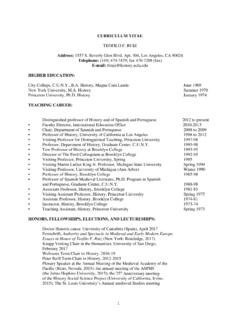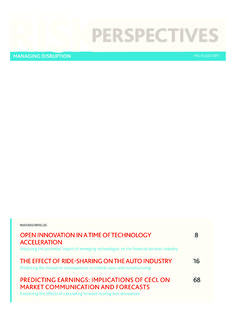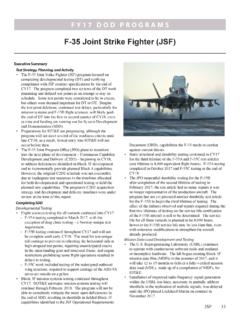Transcription of Notable Articles of 2017 - The New England Journal …
1 Notable Articles of 2017A collection of Articles selected by NEJM editors B Notable Articles of | f: | winter street, waltham, ma 2017 Dear Reader, 2017 was the year of big data. One study took data from 61 million Americans and looked at the association between air pollution and mortality. The trial found that for every increase of 10 g per cubic meter in fine particulate matter ( ), there was an associated increase in all-cause mortality. These findings stress the need for tighter regulation of air-pollutant levels, and make the point that we still have time to make a study analyzed data from million people from 195 countries to find the trends in the prevalence of overweight and obesity among children and adults between 1980 and 2015. This study found that the global obesity epidemic is worsening in most parts of the world, but as with the air pollution study our future is not immutable. As the medical information published in NEJM is regularly used in daily practice, we ensure each paper published meets exacting standards for editorial quality, clinical relevance, and impact on patient outcomes.
2 Among all papers published in 2017 , this most Notable collection was selected by the editors as being the most meaningful in improving medical practice and patient care. We hope that you will take valuable insights from these ,Jeffrey M. Drazen, , The New England Journal of MedicineORIGINAL ARTICLER adiation with or without Antiandrogen Therapy in Recurrent Prostate Cancer..1 EDITORIAL: Improved Therapy for PSA Recurrence after Prostatectomy ..2 ORIGINAL Articles urvival and Neurodevelopmental Outcomes among Periviable Infants ..4 EDITORIAL: Neonatal Intensive Care The Only Constant Is Change ..5 ORIGINAL ARTICLEO simertinib or Platinum Pemetrexed in EGFR T790M Positive Lung Cancer ..8 ORIGINAL ARTICLELong-Term Outcomes of Imatinib Treatment for Chronic Myeloid Leukemia ..9 EDITORIAL: Imatinib Changed Everything ..10 ORIGINAL ARTICLEM epolizumab or Placebo for Eosinophilic Granulomatosis with Polyangiitis ..12 EDITORIAL: Targeting Eosinophils in Eosinophilic Granulomatosis with Polyangiitis.
3 13 ORIGINAL ARTICLEAir Pollution and Mortality in the Medicare Population ..15 EDITORIAL: Air Pollution Still Kills ..16 ORIGINAL ARTICLEH ealth Effects of Overweight and Obesity in 195 Countries over 25 Years ..18 EDITORIAL: Global Health Effects of Overweight and Obesity ..19 ORIGINAL ARTICLET rial of Tocilizumab in Giant-Cell Arteritis ..21 EDITORIAL: Giant-Cell Arteritis More Ecstasy, Less Agony ..22 ORIGINAL ARTICLEA nalysis of Plasma Epstein Barr Virus DNA to Screen for Nasopharyngeal Cancer ..24 EDITORIAL: Plasma Epstein Barr Virus DNA for Screening ..25 ORIGINAL ARTICLEP atent Foramen Ovale Closure or Anticoagulation vs. Antiplatelets after Stroke ..27 EDITORIAL: Tipping Point for Patent Foramen Ovale Closure ..28 PERSPECTIVEL etter to a Young Female Physician ..31 TABLE OF CONTENTSThe New England Journal of Medicine is a publication of NEJM Group, a division of the Massachusetts Medical Society. 2017 Massachusetts Medical Society, All rights reserved.(continued on next page)PERSPECTIVET ragedy, Perseverance, and Chance The Story of CAR-T Therapy.
4 34 PERSPECTIVES tretching the Scope Becoming Frontline Addiction-Medicine Providers ..37(continued from previous page)TABLE OF CONTENTSBack to Table of Contents1 Notable Articles of 2017 ORIGINAL ARTICLERead Full article at new England Journal of medicinen engl j med 376;5 February 2, 2017417established in 1812 February 2, 2017vol. 376 no. 5 The authors full names, academic de-grees, and affiliations are listed in the Appendix. Address reprint requests to Dr. Shipley at the Department of Radiation Oncology, Massachusetts General Hospi-tal, 55 Fruit St., Cox 3, Boston, MA 02114, or at wshipley@ partners . org.* A complete list of the investigators inthe NRG Oncology Radiation TherapyOncology Group (RTOG) is provided in the Supplementary Appendix, availableat Engl J Med 2017 ;376 : 2017 Massachusetts Medical radiation therapy is often necessary in men who have undergone radical pros-tatectomy and have evidence of prostate-cancer recurrence signaled by a persistently or recurrently elevated prostate-specific antigen (PSA) level.
5 Whether antiandrogen therapy with radiation therapy will further improve cancer control and prolong overall survival is a double-blind, placebo-controlled trial conducted from 1998 through 2003, we as-signed 760 eligible patients who had undergone prostatectomy with a lymphadenectomy and had disease, as assessed on pathological testing, with a tumor stage of T2 (confined to the prostate but with a positive surgical margin) or T3 (with histologic extension beyond the prostatic capsule), no nodal involvement, and a detectable PSA level of to ng per milliliter to undergo radiation therapy and receive either antiandrogen therapy (24 months of bicalutamide at a dose of 150 mg daily) or daily placebo tablets during and after radiation therapy. The primary end point was the rate of overall median follow-up among the surviving patients was 13 years. The actuarial rate of overall survival at 12 years was in the bicalutamide group, as compared with in the placebo group (hazard ratio for death, ; 95% confidence interval, to ; P = ).
6 The 12-year incidence of death from prostate cancer, as assessed by means of central review, was in the bicalutamide group, as compared with in the pla-cebo group (P< ). The cumulative incidence of metastatic prostate cancer at 12 years was in the bicalutamide group, as compared with in the placebo group (P = ). The incidence of late adverse events associated with radiation therapy was similar in the two groups. Gynecomastia was recorded in of the patients in the bicalutamide group, as compared with of those in the placebo group (P< ).CONCLUSIONSThe addition of 24 months of antiandrogen therapy with daily bicalutamide to salvage radiation therapy resulted in significantly higher rates of long-term overall survival and lower incidences of metastatic prostate cancer and death from prostate cancer than radiation therapy plus placebo. (Funded by the National Cancer Institute and AstraZeneca; RTOG 9601 number, NCT00002874.)abstractRadiation with or without Antiandrogen Therapy in Recurrent Prostate Shipley, W.
7 Seiferheld, Lukka, Major, Heney, Grignon, O. Sartor, Patel, Bahary, Zietman, Pisansky, Zeitzer, Lawton, Feng, Lovett, Balogh, L. Souhami, Rosenthal, Kerlin, Dignam, Pugh, and Sandler, for the NRG Oncology RTOG* Back to Table of Contents2 Notable Articles of 2017 editorialThe new England Journal of medicinen engl j med 376;5 February 2, 2017484 Improved Therapy for PSA Recurrence after ProstatectomyIan M. Thompson, Jr., developed countries around the world, prostate cancer is the most common solid neoplastic dis-ease. In the United States, approximately half the men with localized prostate cancer undergo radi-cal Prostate-specific antigen (PSA) levels should be undetectable after surgery; a de-tectable PSA level usually indicates disease recur-rence. Almost uniformly, patients who have pro-gression to metastatic disease and subsequently die from prostate cancer present with a detectable PSA level as the first evidence of cancer many patients, residual or recurrent disease is limited to the prostatic bed or pelvis, a phenom-enon that has been confirmed by observations that adjuvant radiation therapy (in patients with high-risk cancer) or salvage radiation therapy (at the time of PSA recurrence) can result in long-term survival without evidence of disease.
8 The progno-sis for patients with PSA recurrence is related to the initial tumor characteristics grade, volume, and local stage. Despite randomized trials show-ing benefits of radiation after prostatectomy, the disease may recur and patients may ultimately die from prostate and colleagues report in this issue of the Journal the long-term outcomes of a random-ized trial comparing pelvic radiation therapy plus 2 years of antiandrogen therapy with pelvic radia-tion therapy plus placebo in high-risk patients who have PSA recurrence after Using a mod-erate dose of radiation and high-dose (150 mg) bicalutamide as the androgen-deprivation therapy, the investigators found a 23% higher rate of over-all survival and a 51% lower rate of death from prostate cancer in the bicalutamide group than in the placebo group. The number needed to treat with the nonsteroidal antiandrogen drug bicalu-tamide to prevent one death from prostate cancer was 20. By comparison, the number needed to treat (surgery or radiation therapy) to prevent one death from prostate cancer has been estimated to be 27, which shows the magnitude of the benefit of antiandrogen As expected, the primary side effect of bicalutamide was gynecomastia, which was seen in 70% of the men treated.
9 This side effect can be distressing but can be mitigated by prophylactic radiation of the breast or by the administration of therapy with high-dose bicalutamide may be used in place of luteinizing hormone releasing hormone based (LHRH) ther-apy to reduce sexual and bone side effects. More commonly, contemporary trials of adjuvant ther-apy have used LHRH-based agents; most data suggest that LHRH-based agents have a similar effect as Higher contemporaneous doses of radiation, delivered with intensity-modu-lated radiation therapy or other techniques, may have greater efficacy than the dose prescribed in the trial conducted by Shipley et al. Given the mag-nitude of benefit that was seen with bicalutamide in this trial, it is unlikely that higher doses of radiation would reduce this benefit, but the treat-ment outcomes would probably be even evidence supporting and guidelines calling for the use of salvage radiation therapy at the time that PSA becomes detectable, in clinical practice, radiation therapy is often not adminis-tered or treatment may be delayed until the PSA level continues to The benefit of the con-clusions of this trial can be accrued only if sal-vage radiation therapy is administered appropri-ately; this is clearly an opportunity for national quality-improvement therapy in combination with radiation therapy is worth serious consider-Back to Table of Contents3 Notable Articles of 2017 Editorialsn engl j med 376;5 February 2, 2017485ation in high-risk patients with PSA recurrence.
10 Nonetheless, in the era of precision medicine, it is our ultimate goal to administer this therapy to patients who are likely to benefit. The RADICALS (Radiation Therapy and Androgen Deprivation Therapy in Treating Patients Who Have Under-gone Surgery for Prostate Cancer) trial (ongoing in Europe and Canada; number, NCT00541047) will help to address this issue by investigating two critical questions. With evidence that adjuvant radiation therapy significantly re-duces the risk of disease recurrence and, in the National Cancer Institute clinical trial,7 reduced the risk of metastases and prolonged survival, the RADICALS trial is comparing adjuvant radiation therapy (in high-risk patients after surgery) with salvage radiation therapy (at the time of PSA re-currence). The other question that is addressed is the duration of androgen-deprivation therapy: none, 6 months, or 24 months. A recent secondary analysis of a randomized trial of androgen-depri-vation therapy showed that the benefit of 6 months of androgen-deprivation therapy added to radiation therapy was seen only in men with no or minimal coexisting Given the range of side effects of androgen deprivation in older men with coexisting conditions, especially in those with early cognitive decline or with the metabolic syn-drome, the use of antiandrogen therapy in lieu of LHRH-based therapies or the omission of hor-monal therapy entirely may be remarkable contribution by the National Clinical Trials Network of the National Cancer In-stitute shows the importance of randomized clini-cal trials with very long follow-up.





